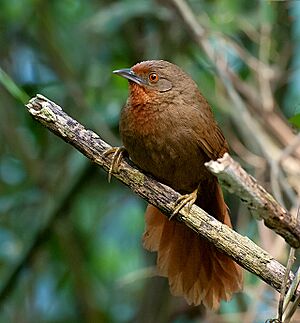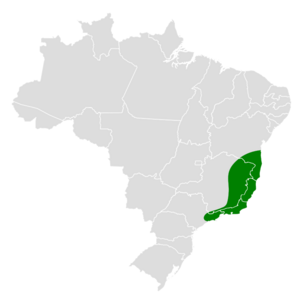Orange-eyed thornbird facts for kids
Quick facts for kids Orange-eyed thornbird |
|
|---|---|
 |
|
| at Serra da Cantareira State Park, São Paulo State, Brazil | |
| Conservation status | |
| Scientific classification | |
| Genus: |
Phacellodomus
|
| Species: |
erythrophthalmus
|
 |
|
The orange-eyed thornbird (Phacellodomus erythrophthalmus) is a special type of bird found only in Brazil. It belongs to the ovenbird family called Furnariidae. These birds are known for building unique nests. This thornbird gets its name from its bright orange eyes!
Contents
About the Orange-Eyed Thornbird
The orange-eyed thornbird is a medium-sized bird. It measures about 16 to 18 centimeters (6 to 7 inches) long. It weighs around 21 to 27 grams (0.7 to 0.9 ounces). Both male and female birds look the same.
What Does It Look Like?
This bird has a rufous-brown face with darker brown areas around its eyes. Its forehead and the front of its head are a bright rufous color. The rest of its head, back, and rump are a dark brownish-olive. Its tail is rufous, which is a reddish-brown color.
Its wings are mostly warm brown. The feathers near its body are brighter, while the tips are duller. The bird's throat is a dark rufous. The rest of its belly is an olivaceous brown, which is lighter in the middle.
The most striking feature is its orange eyes! Its upper beak is black, and its lower beak is gray. Its legs and feet are greenish-gray to gray.
Where Does the Orange-Eyed Thornbird Live?
This bird lives in southeastern Brazil. You can find it from southern Bahia down to northeastern São Paulo state. It lives in the Atlantic Forest biome.
Its Home and Habitat
The orange-eyed thornbird mostly lives in humid lowland forests. It also likes mountain evergreen forests and forests that are growing back. Sometimes, you can find it near small marshes or along rivers in woodlands. It can even be seen in Eucalyptus tree farms and city areas.
It usually lives from near sea level up to about 850 meters (2,800 feet) high. In the southern part of its range, it can live as high as 1,700 meters (5,600 feet).
Orange-Eyed Thornbird Behavior
How It Moves Around
The orange-eyed thornbird stays in the same area all year long. It does not migrate to other places.
What It Eats
Scientists don't know everything about what this bird eats. But they do know it eats insects. It usually looks for food alone or with a partner. It finds its prey by picking insects off plants in the thick bushes of the forest.
Reproduction and Nests
The orange-eyed thornbird usually breeds during the spring and summer in the southern part of the world. This is roughly from September to February. However, eggs and young birds have been seen at other times too.
- They are thought to be monogamous, meaning a pair stays together.
- They build a special nest that looks like a boot.
- The nest is made of thorny sticks and can be about 40 centimeters (16 inches) wide and tall.
- They line the inside of the nest with soft grasses.
- The nest hangs from the end of a tree branch.
- It is usually 1.5 to 4.3 meters (5 to 14 feet) above the ground.
- A female bird usually lays three eggs.
We don't know how long the eggs take to hatch. We also don't know how long it takes for the young birds to leave the nest. Details about how the parents care for their young are also a mystery.
Its Song
The orange-eyed thornbird has a unique song. It's a slow series of up to 15 sharp, ringing sounds that go down in pitch. Some describe it as "chree, chree, chree-tsrééeh-tsrééeh-tsrééeh." The bird usually sings from a branch. Sometimes, a pair of birds will sing together as a duet.
Why Is It Called Orange-Eyed?
For a while, this bird was called the "red-eyed thornbird." But there was another bird, the orange-breasted thornbird, that was also sometimes called "red-eyed." To avoid confusion, scientists decided to give them clearer names. Now, this bird is called the "orange-eyed thornbird" because of its eye color. The other bird is called the "orange-breasted thornbird."
Status of the Orange-Eyed Thornbird
The IUCN (International Union for Conservation of Nature) says the orange-eyed thornbird is a species of "Least Concern." This means it's not currently in danger of disappearing.
- It lives in a fairly large area.
- We don't know exactly how many birds there are, but the population seems to be getting smaller.
- No big threats have been found right now.
- It's not a very common bird, but it does live in several protected areas.
- Because it only lives in a small band of lowlands in southeastern Brazil, it could become vulnerable in the future.


